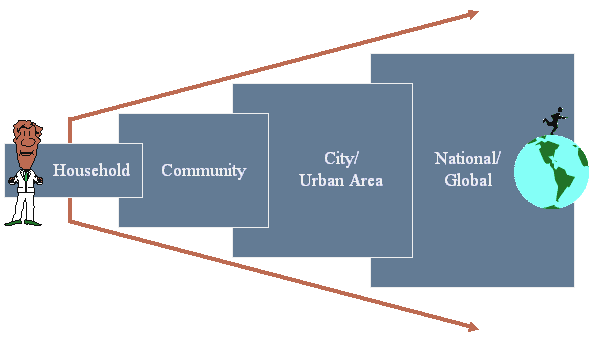Understanding the Scale of
Urban Environmental Problems
 A key to effective policy formulation and allocation of resources to project components is the understanding of the scale of urban environmental problems. This understanding will help us in a variety of ways: collect data and information at the appripriate level, identify resources and stakeholders that function and are involved in the particular scale, formulate policy and take appropriate action at the appropriate level.
A key to effective policy formulation and allocation of resources to project components is the understanding of the scale of urban environmental problems. This understanding will help us in a variety of ways: collect data and information at the appripriate level, identify resources and stakeholders that function and are involved in the particular scale, formulate policy and take appropriate action at the appropriate level.

At each spatial scale, the characteristic problems and the related infrastructure and services needed to address such problems are specified. The consideration of the spatial scale of impacts reveals several important issues for developing countries:
- health impacts are greater and more immediate at the household or community level and tend to diminish in intensity as the spatial scale increases;
- equity issues arise in relation to (a) the provision of basic services at the household or community scale and (b) intertemporal externalities at the regional and global scale - particularly the intergenerational impacts implicit in non-sustainable resource use and global environmental issues; and
- levels of responsibility and decision making should correspond to the scale of impact, but existing jurisdictional arrangements often violate this principle.
| Water pollution |
Loss of habitat, biodiversity and species dedangered |
Region/Nation |
Soil erosion and increased salinity |
Toxic run-off and acid rain |
| Amenity loss |
Traffic congestion |
City |
Loss of heritage and historical buildings |
Reduced property and building values |
| Accidents and disasters |
| Polluted land |
Community |
inappropriate and inadequate technology use |
| Trash dumping |
Household
household health, garbage generation, air/water/noise pollution, spread of diseases
|
|
Lack of understanding of environmental problems |
| Flooding |
Noise pollution |
Natural disasters |
|
Inadequate tax/financial revenues |
| Flooding and surface drainage |
Lack of, and inappropriate, laws and legislation |
| Toxic and hazardous wastes/dumps |
High living densities |
| Loss of agricultural land and desertification |
Air pollution |
Water pollution |
Inadequate supply and transmission loss of electricity |
Misguided urban governments and management practices |
|
| Natural and man-made hazards and disasters |
Land clearance and loss of forest cover |
Effects of climate change and global warming. |
|
|
|
Sources:
- Bartone, Carl, "Annotated Outline of a Report on Strategic Options for Managing the Urban Environment" Washington DC: World Bank, 1991.
- Lee, Yok-shiu, "Myths of Environmental Management and the Urban Poor" in Mega-City Growth and the Future. Tokyo: United Nations University, 1994
- Leitman, Josef, Rapid Urban Environmental Assessment. Volume I: Methodology and Preliminary Findings.. UMP Discussion Paper 14. Washington DC: World Bank
|
